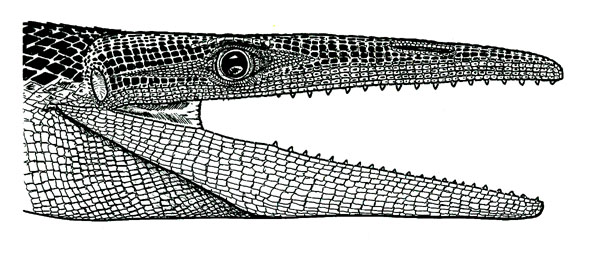
Genus: Ectenosaurus RUSSELL, 1967
Etymology: Greek, ecenes, "drawn-out" and Greek, sauros, "lizard."
= Estenosaurus CALDWELL, 1996 (sic)
Species: clidastoides (MERRIAM, 1894) RUSSELL, 1967
Etymology:
= Platecarpus clidastoides MERRIAM, 1894
Holotype: Formerly at Bayerische Staatssammlung fur Palaontologie but probably destroyed during the Second World War.
Locality: Logan County, Kansas.
Horizon: Smoky Hill Chalk Member, Niobrara Formation.
Biostratigraphy:
Age: Santonian or Campanian Stage, Middle Senonian Subepoch, Uppermiddle Gulf Epoch, Late Cretaceous.
Material: Posterior portion of the skull and several vertebrae.
Neotype: FHSM VP-401 (as per WILLMAN, KONISHI & CALDWELL, 2021)
Locality: Garret Ranch, approximatley 12 km northwest of Wakeeney, Trego County, Kansas.
Horizon: Smoky Hill Chalk Member, Niobrara Chalk.
Biostratigraphy:
Age: Upper Coniacian to Lwoer Santonian Stage, Early Senonian Subepoch, Early Gulf Epoch, Early Late Cretaceous.
Material: Most of skull in articulation, both mandibles, atlas to the 29th prepygal vertebrae all in articulation, ribs, including calcified costal cartilage fragments, sternum, a pair of scapulo-coracodis, and most of right and left forelimb elements.
Referred material:
YPM 4671:
YPM 4672:
YPM 4574:
BELL, 1997Locality:
Horizon:
Biostratigraphy:
Age:
Material:
FHM VP7937:
CALDWELL, 1996
Locality:
Horizon:
Biostratigraphy:
Age:
Material:
FHM-VP 401: Fragmentary skeleton.
= Platecarpus oxyrhinus MERRIAM, 1894
Etymology:Holotype:
Locality: Logan County, Kansas.
Horizon: Smoky Hill Chalk Member, Niobrara Formation.
Biostratigraphy:
Age: Santonian or Campanian Stage, Middle Senonian Subepoch, Uppermiddle Gulf Epoch, Late Cretaceous.
Material: Muzzle.
_____________________________________________________________________________________
Species: everhartorum WILLMAN, KONISHI & CALDWELL, 2021
Etymology: In honor of M. Everhart and P. Everhart, from Kansas, USA, for decades of active paleontological fieldwork in Kansas and resultant scientific contributions at large, including to the field of mosasaur research.
= Ectenosaurus clidastoides LINDGREN, EVERHART & CALDWELL, 2011
Holotype: FHSM VP-5515
Locality: From Smoky Hill River valley exposure about 5 km west of Little Jerusalem, Logan County, Kansas.
Horizon: MU12 or MU13 of Smoky Hill Chalk Member, Niobrara Formation.
Biostratigraphy:
Age: Middle Santonian Stage, Early Senonian Subepoch, Early Gulf Epoch, Early Late Cretaceous.
Material: Disarticulated, incomplete skeleton lacking appendicular elements. Cranial fragments include premaxilla, portions of both maxillae, most of anterior frontal, left upper temporal bar, portions of both dentaries, both splenials, partial coronoids, surangulars, articulars, and a few other miscelaneous bone fragments believed to be part of a the skull. Postcranial material includes two post-axis cervical vertebrae, 19 dorsal vertebrae, 33 caudal vertebrae (5 pygals, 28 intermediates), and a few small pieces of rib.
Note: Has skin impressions.

_____________________________________________________________________________________
Species: tlemonectdes KIERNAN & EBERSOLE, 2023
Etymology: Greek, tlemon, "Paitient" and Greek, nektes, "swimmer"; referring to the 147 years that elapsed between the holotype's discovery in 1875 and its eventual recognition as a distinct taxon in 2022
Holotype: YPM VP4673
Locality: From erosional gullies, Gove County, Kansas.
Horizon: Unknown, Smoky Hill Chalk Member, Niobrara Formation.
Biostratigraphy:
Age: Upper Coniacian-lower Campanian Stage, Senonian Subepoch, Gulf Epoch, Late Cretaceous.
Material: Premaxilla, both maxillae, both dentaries, the posterior ends of both splenials, the anterior ends of both angulars, almost comple left posterior mandibular unit (i.e., surangular, articular, prearticular) and less complete left posterior unit (i.e., fragmentary surangular, articular, prearticular, plus coronodi), frontal, portions of both jugals, almost complete left quadrate, proximal fragment of right quadrate, the posterior end of the right squamosal, fragmentary right pterygoid, much of neurocranium (including the basioccipital, supraoccipital, the left parocciptal process of the opisthotic, and portions of prootic), several assocated teeth or tooth fragments, along with numerous other miscellaneous bone fragments believed to belong to the skull, several cervical and dorsal vertebrae or fragments of vertebrae, all badly distorted and weathered.
Note: Pathologic left dentary tip.
_____________________________________________________________________________________
Species: shannoni KIERNAN & EBERSOLE, 2023
Etymology: In honor of Samuel Wayne Shannon (1951-2020) for his contributions to Alabama Cretaceous vertebrate paleontology throughout the 1970s, also for his co-discovery of the holotype specimen during graduate work at the University f Alabama, Tuscaloosa, USA, and for his early encouragement of the senior author's interest in the mosasauridae.
Holotype: ALMNH:Paleo:5452 (Orginally GSA V1048)
Locality: Kidd from erosional gullies, NE 1/4, SE 1/4 of SEc. 30, T22N, R1E, Greene County, Alabama.
Horizon: Unnamed member, Mooreville Chalk, Selma Group.
Biostratigraphy:
Age: Lower Campanian Stage, Senonian Subepoch, Gulf Epoch, Late Cretaceous.
Material: Frontal, parietal, right splenial, right coronoid, a fragment of left quadrate, numerous indeterminate skull fragments, an incomplete scapula, and several badly weathered vertebrae, including 5 cervicals, 13 dorsals, 5 pygals, and 4 caudals.
_____________________________________________________________________________________